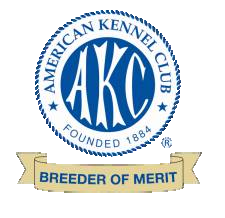Coccidia - Almost every breeder who has 1 or 10 litters a year ends up having coccidia and I have had it in my kennel as well. Note; My pups are treated before they go home with, sulfadimethoxine (Albon®) and parantal pomate.
Coccidia are small protozoans (one-celled organisms) that live in the intestinal tracts of dogs and cats. They cause disease most commonly in puppies and kittens less than six months of age, in adult animals whose immune system is suppressed, or in animals who are stressed in other ways (e.g.; change in ownership, weaned off of mother, dog shows, weather changes, weaning from litter mates, long automobile or plane rides, relocation to a new home and new owners Etc).
In dogs and cats, most coccidia are of the genus called Isospora. Isospora canis and I.ohioensis are the species most often encountered in dogs. Regardless of which species is present, we generally refer to the disease as coccidiosis. As a puppy ages, he tends to develop a natural immunity to the effects of coccidia. As an adult, he may carry coccidia in his intestines, and shed the cyst in the feces, but experience no ill effects. Detectable on routine fecal tests in the same way that worms are, but coccidia are not worms and are not susceptible to deworming medications. They are also not visible to the naked eye.The presence of coccidia in the feces of dogs is fairly common. Up to 72% of dogs may have some level of infection with coccidia. Multiple dog kennels are most prone to infection.
How are coccidia transmitted? A puppy is not born with the coccidia organisms in his intestine. However, once born, the puppy is frequently exposed to his mother's feces, and if the mother is shedding the infective cysts in her feces, then the young animals will likely ingest them and coccidia will develop within the young animal's intestines. Since young puppies, usually those less than six months of age, have no immunity to coccidia, the organisms reproduce in great numbers and parasitize the young animal's intestines.
What are the symptoms of coccidiosis? The primary sign of an animal suffering with coccidiosis is diarrhea. The diarrhea may be mild to severe depending on the level of infection. Blood and mucous may be present, especially in advanced cases. Severely affected animals may also vomit, lose their appetite, become dehydrated, and in some instances, die from the disease if it has become this bad.
Most infected puppies encountered by the authors are in the four to twelve week age group. The possibility of coccidiosis should always be considered when a loose stool or diarrhea is encountered in this age group. A microscopic fecal exam by a veterinarian will detect the cysts confirming a diagnosis. It should be mentioned that stress plays a major role in the development of coccidiosis. It is not uncommon for a seemingly healthy puppy to arrive at his new home and develop diarrhea several days to weeks later leading to a diagnosis of coccidian.
What are the risks? Although many cases are mild, it is not uncommon to see severe, bloody diarrhea result in dehydration and even death that is in very severe cases. This is most common in animals who are ill or infected with other parasites, bacteria, or viruses.
What is the treatment of coccidiosis? Fortunately, coccidiosis is very treatable. Drugs such as sulfadimethoxine (Albon®) and trimethoprim-sulfadiazine (Tribrissen®) have been effective in the treatment and prevention of coccidia. Because these drugs do not kill the organisms, but rather inhibit their reproduction capabilities, elimination of coccidia from the intestine is not rapid. By stopping the ability of the protozoa to reproduce, time is allowed for the puppy's own immunity to develop and remove the organisms. Drug treatments of one to two weeks are usually required, and is very reasonably priced.
How is coccidiosis prevented or controlled? Because coccidia is spread by the feces of carrier animals, it is very important to practice strict sanitation. All fecal material should be removed. Coccidia can withstand freezing. Flies can mechanically carry coccidia from one place to another. Mice and other animals can ingest the coccidia and when killed and eaten by a dog, for instance, can infect the dog. Therefore, insect and rodent control is very important in preventing coccidiosis. Oocysts (pronounced o'o-sists), are passed in stool. In the outside world, the oocysts begin to mature or sporulate. After they have adequately matured, they become infective to any host (dog or cat) that accidentally swallows them.To be more precise, coccidia come from fecal-contaminated ground. They are swallowed when a pet grooms/licks the dirt off itself.
Dogs should be prevented from access to foul water that may contain large numbers of oocysts (e.g.: river-flooded paddocks). Small numbers of oocysts may occasionally be present in the potable water supply but the risk of this being a major source of infection is small. It is best to use chlorinated water for your dogs drinking water as much as possible. If you are using non-chlorinated water from a well, lake, or stream, you need to chlorinate the water yourself.
Coccidiosis is frequently referred to as an opportunist – a disease that will develop when other stress factors are present. For example, the highest incidence of coccidiosis is in the first days after a dog has changed owners and moved to a new residence. If a normal animal carries oocysts, it is relatively easy for rapid development when the conditions are right – adverse weather, shipping, dog food changes, new owners, new residence, and other stresses are important.
Can my cat get coccidia from my dog? A dog infected with coccidia cannot pass the infection to cats and vice versa. Coccidial infections occur only by swallowing the coccidia in soil or dog feces.
The coccidia species of dogs and cats do not infect humans.

